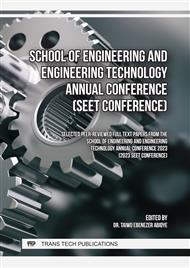p.111
p.121
p.131
p.139
p.149
p.161
p.183
p.191
p.203
Design of a Ceiling Fan with Autonomous Capability
Abstract:
The unkempt state of many ceiling fans in offices, homes and industries due to poor maintenance in term of cleaning and the wastage of energy as a result of carelessness in appliance usage inform the design of a ceiling fan with autonomous capability. The design of the ceiling fan was done using appropriate design equations and Solidworks CAD software. Different concepts were conceived and the best concept was determined using one of the Multi – Criteria decision Tools named Pugh Matrix Method. After which, simulation was done using ANSYS and Proteus 8.1 design suite to test functionality of the design. The outcome shows that at no load in the room, the ceiling fan switches off automatically and also when occupants are in the room with an increase in temperature above ambient temperature (25 °C), the ceiling fan switches on. The simulation results analysis of stress, strain, shear force, deflection, factor of safety and bending moment on the embedded cleaner gave 112.717 MPa, 0.007496, 5 N, 60.28 mm, 1.8346 and 0.8965 Nm respectively. Furthermore, the result revealed that the autonomous capability of the cleaning mechanism gave an efficiency of 85%. The cost to implement this innovation is estimated at twenty five dollar.
Info:
Periodical:
Pages:
149-160
Citation:
Online since:
July 2024
Keywords:
Price:
Сopyright:
© 2024 Trans Tech Publications Ltd. All Rights Reserved
Share:
Citation:


